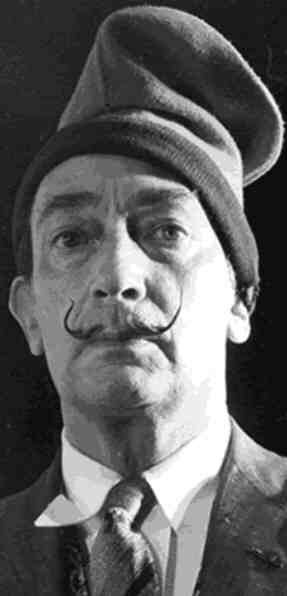 ^
Died on 23 January 1989:
^
Died on 23 January 1989: Salvador Felipe Jacinto Dalí i Domenech,
Spanish Surrealist painter and printmaker born on 11 May 1904.
— Spanish painter, writer, and member of the surrealist movement. He was born in Figueras, Catalonia, and educated at the School of Fine Arts, Madrid. After 1929 he espoused surrealism, although the leaders of the movement later denounced Dalí as overly commercial. Dalí's paintings from this period depict dream imagery and everyday objects in unexpected forms, such as the famous limp watches in The Persistence of Memory. Dalí moved to the United States in 1940, where he remained until 1948. His later paintings, often on religious themes, are more classical in style. They include Crucifixion and The Sacrament of the Last Supper. Dalí's paintings are characterized by meticulous draftsmanship and realistic detail, with brilliant colors heightened by transparent glazes. Dalí designed and produced surrealist films, illustrated books, handcrafted jewelry, and created theatrical sets and costumes. Among his writings are ballet scenarios and several books, including The Secret Life of Salvador Dalí (1942) and Diary of a Genius (1965).
— Dali was born in the small agricultural town of Figueres, Catalonia, in the foothills of the Pyrenees, 25 km from the French border, the son of a prosperous notary. He spent his childhood in Figueres and at the family's summer home in the coastal fishing village of Cadaques. His first studio was built for him by his parents and was situated in Cadaques. For most of his adult life he lived in a fantastic villa in nearby Port Lligat.
As a young man, Dali attended the San Fernando Academy of Fine Arts in Madrid. His first one-man show was held in Barcelona in 1925. He got international fame when three of his paintings were shown in the third annual Carnegie International Exhibition in Pittsburgh in 1928.
Dali went to Paris the following year, again holding a one-man show, and joined the Paris Surrealist Group. It was in this same year that Dali met Gala Eluard when she visited him in Cadaques with her husband, the French poet Paul Eluard. She became Dali's lover, muse, business manager, and the source of inspiration for many of Dali's greatest works. They were married in 1934 at a civil ceremony and made their first trip to America.
Dali emerged as a leader of the Surrealist movement and his painting, Persistence of Memory (1931) is still one of the best known surrealist works. But, as war approached, the apolitical Dali clashed with the Surrealists and he was expelled during a trial conducted by the group in 1934. Although he did exhibit works in international surrealist exhibitions throughout the decade, asserting: “le Surréalisme c'est moi”, by 1940 he was ready to move into a new era, one that he termed “classic.”
During World War II Dali and his wife, Gala, took refuge in the United States, returning after the war's end to Spain. His international reputation continued to grow, based as much on his flamboyance and flair for publicity as on his prodigious output of paintings, graphic works, and book illustrations; and designs for jewellrey, textiles, clothing, costumes, shop interiors, and stage sets. His writings include poetry, fiction, and a controversial autobiography, The Secret Life of Salvador Dali.
 —
The Ghost of Vermeer of Delft Which Can Be Used as A Table
(1934) _ This is one of Dalí's most precise "miniatures." The artist described
such work from the mid 1930s as "hand-painted photographs in color," and
indeed the precision of detail and luminosity of this painting give it the
appearance of a photograph. Such detailing shows the influence of the Dutch
painter
—
The Ghost of Vermeer of Delft Which Can Be Used as A Table
(1934) _ This is one of Dalí's most precise "miniatures." The artist described
such work from the mid 1930s as "hand-painted photographs in color," and
indeed the precision of detail and luminosity of this painting give it the
appearance of a photograph. Such detailing shows the influence of the Dutch
painter 
 —
The Disintegration of the Persistence of Memory (1954)
_ In this Dalí disintegrated the scene from his popular 1931 painting The
Persistence of Memory. This disintegration is an acknowledgment of
the developments of modern science. The disquieting landscape of his earlier
work has here been shattered by the effects of the atomic bomb. All of the
elements in the painting are separating from each other. The rectangular
blocks in the foreground and the rhinoceros horns floating through space
metaphorically suggest that the world is formed of atomic particles that
are constantly in motion.
—
The Disintegration of the Persistence of Memory (1954)
_ In this Dalí disintegrated the scene from his popular 1931 painting The
Persistence of Memory. This disintegration is an acknowledgment of
the developments of modern science. The disquieting landscape of his earlier
work has here been shattered by the effects of the atomic bomb. All of the
elements in the painting are separating from each other. The rectangular
blocks in the foreground and the rhinoceros horns floating through space
metaphorically suggest that the world is formed of atomic particles that
are constantly in motion.